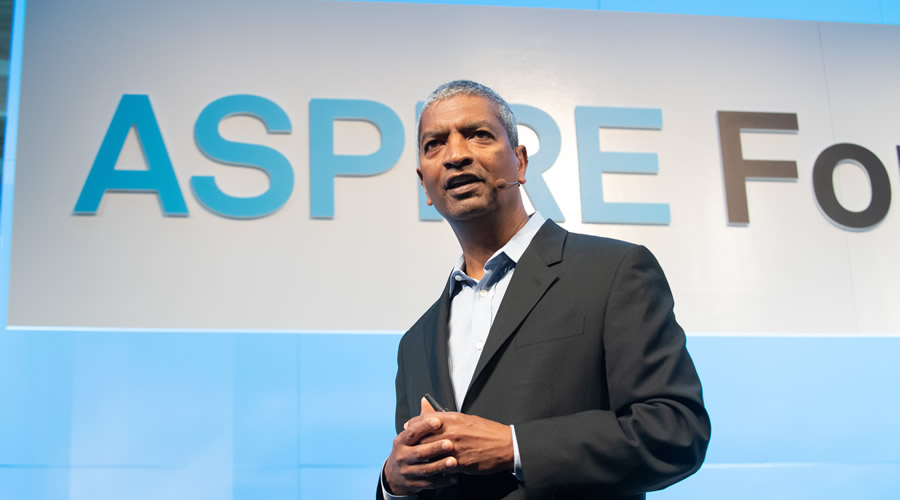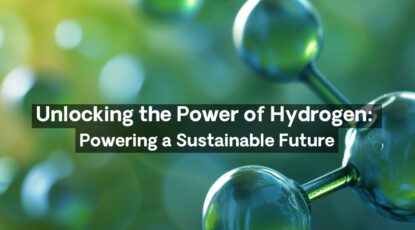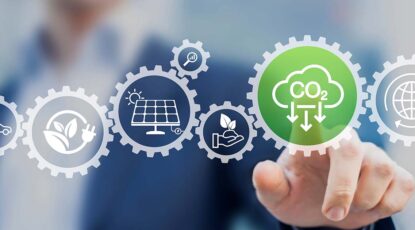It is inconceivable that a child born today can experience a basic, decent lifestyle without access to adequate electricity. Yet, almost a century and a half after the invention of the electric grid, over 1 billion people on the planet are without access to electricity and more than double that number cannot afford it.
In a world where everything is going digital, unprecedented levels of electricity availability and reliability will be required. At the same time, the climate crisis requires that these demands be met while lowering carbon emissions.
We face a global challenge to design, build and retool the electric infrastructure to combat climate change and also expand economic opportunity. It will require a portfolio approach that employs different strategies depending on geographic attributes, economic realities and the readiness of alternative technologies.
The growing demand for essential electricity and the knowledge that the climate cannot sustain the status quo require that we rethink how to shape the transforming global energy marketplace. In both established economies with a centralized grid and in emerging economies that do not have access to grid infrastructure, the role of independently operable, resilient microgrids will be critical in shaping the transformation.
Download: Electricity in the Digitized World
The New Role of Microgrids
In places that have a well-developed grid infrastructure, smart hybrid systems that will be a combination of a centralized grid coexisting with high availability microgrids will be the basis for future power architectures. As recent events in California have demonstrated, climate change-driven natural disasters have heightened the vulnerability of centralized grids, creating an intolerable threat to electricity reliability.
In emerging economies and remote areas that do not have access to or adequate grid infrastructure, communities can leapfrog to an architecture of distributed generation and microgrids without having to shoulder the massive capital costs of building a central grid infrastructure. This concept is similar to what we saw in communications technology, when areas not served by land lines transitioned directly to cellular technology.
We founded Bloom Energy in 2001 with the mission to deliver clean, reliable, affordable energy to everyone, everywhere. We built the groundwork necessary to fulfill this ambitious goal. Nearly two decades later, global trends and events have shown why the transformation is essential. The importance of our mission has become even more evident. Why?
In this decade, the world population has grown by about 800 million, global GDP by about $19 trillion and global carbon emissions by about 1.5 billion tons. To combat climate change successfully, the connection between global population, GDP growth and increasing carbon emissions has to be broken. We cannot expect implementation of policies that offer up a false choice between either improving the economic well-being of the global population or protecting Earth’s climate.
To solve the climate crisis it is important to understand and appreciate the social, economic, generational, and moral aspects of the issue at a global level. It is equally important to understand the feasibility of the various solutions being proposed from scalability, technology readiness, time scales for implementation, and cost perspectives.
2020 predictions: The top energy trends we’re anticipating this year
Reaching Global Decarbonization Goals
Understandably, there is generational tension. Our younger generations want the grown-ups to act with urgency to decarbonize the world and combat climate change for their sake and that of future generations.
Even greater tension exists between the rich and the poor — between advanced economies that grew without carbon constraints and emerging economies that fear the potential impediments of carbon constraints may place on their advancement.
For many low-income populations, the challenge of day-to-day sustenance is overwhelming enough. Climate change does not find a place on their priority list.
World Bank data for high-income countries that have a total combined population of about 1.2 billion indicate that their GDP totaled $54 trillion in 2018. The annual carbon emission per person for this group was 11.3 metric tons.
On the other end of the spectrum, low-income countries with a combined population of about 700 million had a total GDP of $573 billion and their per-capita emissions number was 0.3 metric tons, a mere 2.65 percent of those in the richer nations.
No country or population group that is energy poor is economically rich. There are no proven pathways for poor nations to economically develop without increasing their energy consumption. Thus, the challenge is evident: We must develop electrical infrastructure that enables population and economic growth without further imperiling the future of the planet.
The current push to increase the percentage of renewables in our energy mix and extract efficiency gains from end-use applications is critically important, and should continue.
Finding ways to increase the carbon efficiency of electricity production using fossil fuels is also critically important. Deploying Carbon Capture Utilization and Sequestration (CCUS), promoting safe nuclear power, producing power from waste-based biomass, using storage, developing demand response, and finding pathways to lower the energy need for a quantum increase in GDP are also all vitally important and necessary ways to reach global decarbonization goals.
Confronting the costs and consequences of day(s) without power
Using Every Tool Available to Reduce Carbon Emissions
We must use every tool available to reduce carbon emissions at the fastest pace possible, using all means.
As recent events in California have shown, building a climate-sensitive electric infrastructure across a diverse portfolio applies not just to developing economies but also to established ones. In architecting energy infrastructure, consideration should be given to multiple factors including:
- Providing a pathway to economic growth for middle- and low-income economies that is realistic, scalable, timely, affordable, accessible, and has a low to zero carbon footprint.
- By 2050 most of the increase in world population, about 2 billion, will occur in low- income parts of the world that will need significant growth in affordable electricity.
- Another 4 billion people will aspire to climb the economic ladder and will expect their leaders and nations to provide the energy wealth required to create economic wealth.
- Unlike in the past decades, the expectation of electricity access for these populations will not be just a few lights and a charging port, but meaningful per-capita energy for personal economic growth.
- Increasing global temperatures in many countries will require a significant increase in electricity needs for cooling purposes.
- In this digitized world, higher levels of electricity availability and reliability will be essential. The notion of having power-quality and power-disrupted is unthinkable when electrically operated life-saving devices are ubiquitous, medical surgeries are reliant upon electronic robotics, and autonomous vehicles are powered by electricity. As we transition to electrification of automobiles, not having power to charge vehicles before, during or after natural disasters will not be acceptable. Intermittent renewables, storage and centralized grid alone will not be able to meet these stringent requirements.
- As we transition to the new power paradigm, lessons need to be learned from the best practices that the trailblazers have established, as well as the mistakes they have made.
- California has become a leader in fighting the causes of climate change and has significantly reduced the carbon footprint of its electric supply. Its use of solar and wind power to reduce the carbon footprint of power is commendable. However, it has failed to implement policies to address the consequences of climate change and protect its people and property from climate-related disasters. The unprecedented extended power outages to millions of people necessitated by the lack of resiliency in the power architecture is a mistake that should not be repeated. The current practice of using local, combustion-based back-up generators that are typically located in low-income neighborhoods and emit pollutants that cause cancer and respiratory illnesses is problematic from health, environmental and social justice perspectives.
- Enacting “feel good” local and regional policies and laws that have the indirect consequence of driving energy-intensive businesses away from environmentally progressive regions to reduce regional carbon footprint is another mistake. Such policies tend to push businesses to places with dirtier (and cheaper) power and have a negative impact on both the global environment and the local economy. Such actions imperil the jobs of the working class and may create backlash to climate policies. However, incentivizing traditionally energy-intensive businesses with policies to stay local and reduce their carbon footprint can benefit the environment, position the industries for a better future and secure the buy-in of the working class.
- The need to deal with the resiliency of the grid becomes even more critical as we deal with the consequences of climate change. The science indicates that natural disasters will be more intense, frequent and ubiquitous with time. The wildfires, hurricanes, flooding, tornadoes, extreme heat and cold that we are experiencing globally are a harbinger of what is to come.
- The topology of the centralized grid has the tendency to cascade outages rather than contain them, making it an unsuitable carrier of electrons when resiliency is needed.
- One other consideration for the need for resiliency comes from the potential of bad actors to weaponize our electric grid through cyber and physical attacks. As societies and economies become more dependent on electricity, the centralized electric grid becomes more of a prime target, and the prospect of disruption of electricity to create mayhem becomes more likely. Along with efforts to secure the grid, it is paramount that critical infrastructure be protected by micro-grids.
Our Solutions Are Transforming the Power Industry
Based on these megatrends, we at Bloom Energy believe that we are architecting an energy platform that can address the needs of the transforming power industry in very significant and unique ways.
Sustainability: In the area of decarbonization, Bloom Energy Servers offer the best-of-class carbon footprint when operating on natural gas and many pathways to zero carbon electricity. The pathways to zero carbon base-load electricity include biogas, hydrogen, and carbon capture utilization and storage (CCUS). Eventually, when Bloom systems are used with biogas and captured and geologically stored, electricity will be generated with negative carbon footprint, effectively removing carbon from the atmosphere. In all cases, the Bloom servers emit virtually no smog pollution since there is no combustion and there is no use of water during normal operation.
Reliability and resiliency: The modular, fault-tolerant architecture of the Bloom Energy Server system includes power modules that can be serviced without power interruption. They offer an unprecedented level of availability for a customer and avoid all the risks associated with the failure of a power transmission and distribution system. The distributed architecture of Bloom is inherently more resilient than the current centralized generation and delivery grid model.
Personalization: Bloom Energy Servers can provide power to customers based on their customized needs. The reliability needs of mission-critical facilities such as hospitals, trading floors, airports or first responders vary from the business-continuity needs of commercial facilities, gas stations, and shopping venues. Similarly, the needs of large businesses and university campuses are different from those of single-family homes. With a Bloom solution, the reliability for any location can be tailored for its needs with the appropriate level of redundancy.
Power Outage Solutions: How Businesses Can Protect Themselves from Blackouts
Powering the Future
Going forward, many power-intensive applications such as data centers and electric vehicle charging will use direct current as opposed to procuring alternating current from the grid and converting that to direct current at an expense and efficiency loss. Bloom natively provides base-load direct current output. In addition, the output power, ac or dc, can be delivered at the most commonly used voltages with minimal or no “stepping” transformers, thereby reducing unnecessary power losses, added costs and increased carbon footprint.
Based on the geography and the kind of facility being powered, there will be a need to integrate on-site generation sources such as solar, micro-wind, storage etc. The Bloom Server’s built-in direct current “electrical bus” is a perfect platform to integrate these technologies seamlessly and offer a customized micro-grid that is AlwaysOn.
The fuel flexibility of our systems allows customers to use the fuel of best choice for a location — natural gas, biogas, or hydrogen
We will continue to serve customers that require premium power with their customized needs using our unique platform. We currently offer a variety of personalization capabilities and are excited about the pipeline of other decarbonization options that are on our development roadmap.
Affordability, Reliability, and Resiliency
The True Cost of Electricity
Before we discuss affordability, it is important to distinguish the bulk generation cost from the delivered cost of electricity. While the cost of generation from conventional facilities fell in the past few years due to lowering fuel prices and the declining cost of renewable generation, the price paid for electricity by consumers is increasing. At the same time, the quality of the service, as measured by reliability and resiliency, is decreasing. This is the case because generation-related costs are, shrinking as a percentage of the total cost of delivered power. The majority of the remaining cost is attributed to transmission and distribution related costs. In some parts of the world, commercial losses from delinquency of payment and theft also play a big part in the total cost of delivered power.
Global trends indicate that as the percentage of intermittent renewable sources increases in a grid, the integration costs that are needed to firm up the power and balance supply with the demand increases sharply. If storage, rather than fossil fuel based conventional power, is used for the firming of power, the costs are even higher.
Additionally, there is the repeated cost of repairing, hardening and maintaining the grid in a post-climate-change world with frequent and severe natural disasters.
From a customer viewpoint, the true comparison is the quality of service they experience behind their meter and the price they pay for that service in monthly utility bills. Seen this way, Bloom Energy offers a very attractive value proposition to our customers in the markets we serve. Our electricity is cleaner, more reliable and more resilient than the grid service, and it is both lower and more predictable in cost.
Affordability for All
It is very important that we at Bloom provide electricity that is affordable to everyone. One of the core objectives at Bloom is to continuously reduce the cost of delivered electricity to our customers. As we reduce the cost of delivered electricity, we transition from premium offerings and mainstream offerings in select high-price electricity markets to a premium and mainstream offering in all markets. We have been executing on our cost-reduction strategy over the last decade with great success and will continue on this path until we achieve our goal. We achieve lower delivered costs by reducing the costs of all the elements that add up to the delivered electricity cost – namely, capital cost, installation cost, fuel costs and operation and maintenance cost.
Our capital, or hardware costs have dropped by approximately 27 percent every time our cumulative production volume doubles, which is in line or better than other energy technologies such as wind and solar. The latest generation Energy Server delivers five times the electricity output of the first generation in a constant footprint. The next generation now under development will deliver 50 percent more power than the latest generation in the same footprint. We expect to continue this trend of power density improvements in the future.
As our power density (output power for a unit of land) increases, the total land use and the installation costs per kW are reduced, thereby lowering the cost of electricity.
The fuel costs to produce power goes down as the amount of fuel required to produce the power goes down. The higher the efficiency of an Energy Server, the lower the fuel use and the lower the fuel costs. The beginning-of-life efficiencies of the Bloom servers have increased from the high-40s of the first generation to the mid-60s in the current generation. We expect the efficiency to improve further in succeeding generations.
The fuel cell-based energy servers start at a certain fuel efficiency, termed beginning-of-life efficiency, and like all electrochemical systems degrade in performance over time. We choose to end the useful life of our servers when we reach a fuel efficiency of 45 percent. Bloom Energy has continually improved the useful operating life of our fuel cells by increasing the starting efficiency of the servers and lowering the rate at which the efficiency degrades. The duration between replacement of fuel cells has gone from under two years to over five years in the last decade based on these efforts. We have a repair and overhaul facility that enables the reuse many of the components from the units we swap out to the refurbished units we replace. This practice makes our operations more sustainable and lowers our maintenance cost. These and many other initiatives enable us to continuously lower our service cost and in turn lower the delivered cost of electricity. We design our new generation of energy servers to be compatible with the past generations of servers, thereby offering the best and latest technology of fuel cells to our customers when we perform service replacements.
Accessibility for All
We at Bloom Energy want to provide easy access to electricity for our customers everywhere.
The energy appetite of cities around the world continues to grow, due mainly to population increase, economic growth, digitization, growing air-conditioning requirements and electrification of transportation. The reliability requirements for many of these applications necessitates that the power source be near the application rather than remote. Access to such power is only possible with technologies that have very high power density and availability. Bloom Power Towers, which are Bloom Energy Servers stacked vertically similar to city parking structures, offer very high power density with minimal land use. The quietness of such towers, lack of smog forming emissions, absence of smoke chimneys, “pay as you grow,” modularity, quick “time to power” are all features that facilitate ease of accessibility.
Our Bloom Server platform is well poised to serve the needs of the large and growing electricity market that is transforming. We are excited for the future and the role our solutions will play in this transforming marketplace with a relevant platform product that will bring about positive change in so many ways to the world. Together, we will empower a better tomorrow.
Best Regards,
KR Sridhar
CEO
Bloom Energy



